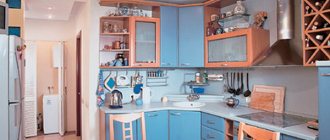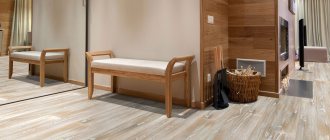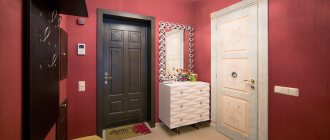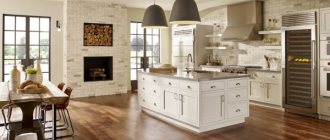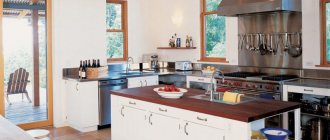Purpose of the kitchen
How does the kitchen move into the room along with communications?
What is a kitchen in a modern apartment? First you need to understand whether this is a residential or utility room, because the requirements for the parameters and operation of both are different.
Let's turn to the provisions of the law. The Housing Code of the Russian Federation (Federal Law No. 188 of 2004) prevails here.
Residential and utility rooms
The first part of Article 16 of the RF Housing Code refers to residential premises:
- Apartments and their parts. An apartment is a dedicated space in an apartment building, consisting of one or more rooms. As well as auxiliary premises, those that provide for a person’s everyday needs (Part 3 of Article 16).
- Rooms. This is a narrower concept with exclusively residential purpose of premises (Part 4 of Article 16).
In fact, it turns out that the kitchen is part of the apartment (living space) with an auxiliary purpose. This square is not intended for direct living.
Moving the kitchen to the hallway
Most often, the kitchen is moved into the hallway, since such redevelopment does not have strict restrictions. At the same time, much depends on the original area of the corridor, hall or hallway.
If the size of the corridor is large enough, then it is possible to arrange a full-fledged kitchen in it, but it will be necessary to ensure the presence of a direct source of sunlight, that is, to comply with the established requirements for insolation of the kitchen space. And also carry out the transfer of communications.
It is also possible to move the kitchen to a smaller corridor with a kitchen niche without a dining area, equipped with an electric stove, supply and exhaust ventilation and sewerage. It should be borne in mind that the minimum size of a kitchen niche is 5 square meters. m. Then coordinating the transfer of the kitchen to the corridor is feasible.
It is also possible to move the kitchen to other non-residential premises of the apartment - to the utility room, pantry or dressing room. The main thing is that these rooms are of sufficient area to install a kitchen in them and do not have access to the living room. If the entrance to the pantry (utility room, wardrobe, built-in wardrobe) leads from the living room, then moving the kitchen to the area it occupies is carried out according to the same rules as moving the kitchen into the room.
Kitchen remodeling and its features
How to turn a kitchen into a room? Kitchen remodeling is a complex undertaking, both technically and legally. First of all, the principles of using residential premises are taken into account:
- taking into account the rights and interests of neighbors;
- compliance with fire safety standards;
- compliance with sanitary and hygienic standards.
These are not recommendations, but requirements set out in the Rules for the Use of Residential Real Estate. When moving the kitchen into a room, they are often broken.
Unacceptable actions
Is it possible to place the kitchen above the living room?
The owner will have problems with supervisory authorities if:
- placement of bathrooms and toilets above kitchens and living spaces (SanPiN 2.1.2.2645-10; SNiP 31-03-203);
- moving the kitchen to the living room (clause 22, Decree of the Russian Federation No. 47 of January 21, 2006);
- placement in the freed-up area of a bedroom, nursery or even living room;
- combining a gasified kitchen with rooms for permanent residence.
Possibility of moving the kitchen into the room
Let us immediately note that in most apartments in residential buildings there is no possibility of moving the kitchen to the living area. The reason for this is the existing ban on placing kitchens above living rooms (clause 24 of the Decree of the Government of the Russian Federation of January 28, 2006 No. 47).
In apartment buildings, apartments located above each other usually have identical layouts. Accordingly, if you transfer the kitchen to the living room, then the transferred kitchen space will be above the living room of the apartment from below, and this is prohibited.
However, permission can be obtained for this type of redevelopment if there is a non-residential premises located under the living room where the kitchen is planned to be moved. This happens if:
- The apartment is on the first floor.
- Under the apartment, on the floor below, there are non-residential objects (commercial real estate, public organizations, etc.).
- In the lower floor apartment, the owner legalized the redevelopment by moving the kitchen into the room.
According to current legislation, we agree on moving the kitchen into the room along with communications only in these three situations. Let us give a short explanation for each of the presented options.
There are no living quarters below the first floor apartment of an apartment building, so moving the kitchen into the room does not violate anything, and therefore is completely acceptable.
If the apartment is located on the second floor or higher, but below there are non-residential premises (shop, cafe, bank, medical center, etc.), then the second floor, in the sense of moving the kitchen into the hall, is equal to the first, that is, here too the redevelopment is feasible, since clause 24 of the Russian Federation Regulations dated January 28, 2006 No. 47 is not violated.
Coordination of moving the kitchen into the living room is also possible for apartments above the first floor, if the neighbor below has completed exactly the same redevelopment. In this case, the relocated kitchen will not be above the living room of the neighbor’s apartment, but above its kitchen space. But this option will “pass” approval only on the condition that the neighbor’s redevelopment is not unauthorized, but legal, with changes made to the BTI database.
Moving the kitchen to the living room on the ground floor in a one-room apartment.
This measure is not “directly” feasible, since if we technically move the kitchen into the living room, it will turn out that our living room has become a kitchen, and our kitchen cannot be a living room, since the location of kitchens above living rooms is prohibited. As a result of such redevelopment, it turns out that there is no living room left in our apartment. And the apartment must have at least one living room.
However, if we have, say, a pantry or a large corridor, then it is possible to move the kitchen there with the installation of a kitchen niche. We will tell you more about this below.
That is, our kitchen will be located not in the living room, but in the corridor. Or it can even partially cover the living room, provided that the area of the living room after this remains no less than the normalized one. We approve such redevelopments and develop projects based on them quite often, since this option is popular with owners or buyers of one-room apartments who want to turn it into a two-room apartment.
Relocation of the kitchen on the ground floor in two or more room apartments.
If the owner has a 2 or more room apartment, then moving the kitchen usually does not present any difficulties, since it turns out that even if we move the kitchen into the living room, we still have at least one more living room. Therefore, this option is the most problem-free from the coordination side.
Moving the kitchen into the living room in a new building
Many modern new buildings in Moscow and the Moscow region are represented by apartments with an open plan, that is, without internal walls. When buying housing of this type, some owners quite sincerely believe that they can do whatever they want with the purchased apartment. In particular, you can arrange different rooms in it however you like. After all, they are the rightful owners of the apartment, and the layout is “free,” so why not move the kitchen into the living room?
However, it is not. The procedure for redevelopment is the same for all apartments. Therefore, moving a kitchen into a studio, a one-room apartment, two or more rooms, in any new building, including apartments with an open plan, is carried out according to the same rules. That is, in new buildings, just like, for example, in Brezhnev buildings, you cannot place the kitchen above the living room of the neighbor’s apartment.
We talked in more detail about coordinating redevelopment in apartments with an open plan here.
Relocating a kitchen in Khrushchev
It must be said that even on the ground floor, moving the kitchen into the living room is not always agreed upon. There is another factor on which the possibility of such a redevelopment depends. We are talking about the type of stove installed in the apartment.
To move the kitchen into the room, there is a mandatory requirement - it must be equipped exclusively with an electric stove. It is strictly prohibited to locate gasified premises above and below residential premises.
In this sense, coordinating the transfer of the kitchen to the living room in a Khrushchev-era apartment building is considered difficult to implement, since the kitchen areas in such houses are equipped primarily with gas stoves.
How to legalize the transfer of a kitchen into a living room - options for standard apartments
How can you redesign a kitchen in a typical apartment?
There are no problems with moving the kitchen into living rooms:
- In two-level apartments.
- For residents of the top floors, without affecting the contact areas of bathrooms and other auxiliary premises of residents of the lower floor.
- The conditions are feasible in apartments on the first level of the building, located above shops and other non-residential premises.
In the above cases, there is no deterioration in the living conditions of other citizens, but plans still need to be coordinated. For approval, you will have to think carefully about your options.
Possible solutions
Moving the kitchen to the living room
How to move a sewer to another room
Today it is possible to redesign a Soviet-built apartment at your own discretion. Statistics show that such renovations are done quite often, and the trend is explained by the need to equip a large kitchen, bathroom and toilet. In addition, sometimes it is necessary to move the sewer system to another room due to the optimal connection of household appliances, in particular this applies to dishwashers and washing machines.
If the task arises of moving the bathtub to a certain distance from the collector, then it is necessary to provide for the possibility of clogging in the elongated sewer pipe. In this case, it is important to choose the right solution to a possible problem. The most difficult way is to move the riser; one might even say that this task is practically impossible. Apartments located on the first or last floor have a better chance. In the worst case, if necessary, you have to use a modern sewage system with a built-in pump, which operates automatically.
bathroom layout diagram in a standard house
Moving the kitchen into the living space
As a rule, most holidays with guests are held in the kitchen, so this room can be universal. Here you can not only cook food, but also have friendly gatherings. Of course, it will be more convenient if the kitchen is large, but not everyone has such a luxury. In this situation, the best option is to move it to another room and carry out special repair work.
So, if you wish, you can really make a kitchen in:
When planning to move the kitchen to another place, many people wonder how correct and legal these actions are? In fact, it is allowed to move the kitchen, only for this you need to draw up special documents and take into account the mandatory requirements.
Under what conditions can a transfer be made?
Before carrying out such an event, it is important to obtain a special permit, which must be issued for the redevelopment of a residential premises. All documentation for such actions must be developed taking into account current regulatory documents, which contain clarifications and certain prohibitions.
preparing the room and walls for laying pipes for moving sewerage
For example, a transfer cannot be done if:
- conditions for comfortable living are violated. Until recently, this feature was not considered. Previously, the owner simply independently decided to sign a document agreeing to change the conditions or not. Now such receipts have no meaning;
- violation of the technological instructions of communication networks is provided. In particular, this applies to work with electrical or sewer networks. In such situations there is a risk of disapproval. As statistics show, few people pay attention to such a requirement; the only important thing is that free access to the sites of network redevelopment is provided;
- connecting rooms with different average temperatures. Thus, you cannot move the kitchen into a room combined with a balcony or loggia. In such situations, it will be necessary to change the heating system, ensuring its output to the balcony, which is an action prohibited by technological standards.
When planning to move the kitchen into a living space, it is important to take into account the smallest details; this is the only way to quickly get approval for these actions. These are not all the conditions, but they are considered the most important.
When is it prohibited to move the kitchen?
Recommended reading: Sewer pumping machine
In addition to certain conditions, you need to know that there are also some mandatory legal points on the basis of which redevelopment is not allowed.
layout of a separate bathroom after relocating the sewer system
In separate columns of construction and sanitary standards, points are indicated that deal with these prohibitions:
- It is prohibited to move the kitchen into a living room located above the adjacent living area. Just like the bathroom and toilet, the kitchen is considered to be a room with an increased water hazard. If it is flooded, the neighboring apartment will also suffer;
- It is prohibited to equip a kitchen in a bathroom or toilet. Even if the bathroom area allows you to create a small kitchenette, it simply won’t work. This is explained by the fact that the volume of the room being moved can encroach on the area of the toilet, and this deteriorates living conditions.
Despite this, many have heard more than once that such a transfer can be carried out legally. In fact, this is so, there are official regulations, as well as some tricks and solutions to the problem:
- the kitchen can be easily transferred to residents who live on the ground floor, since there is no violation of the living conditions of the neighbors below;
- There are no special restrictions for owners of multi-level apartments. Housing conditions are violated only for those owners who carry out redevelopment;
- It is allowed to move the kitchen to a place that is not considered residential by the neighbors below, for example, it could be a storage room or a corridor.
Such redevelopment is possible if the apartment is located above a store or similar premises. Since the administrative building cannot be residential, redevelopment is allowed.
The issue of moving household appliances
In the process of remodeling a kitchen, the question arises about moving household appliances and kitchen utensils.
laying and checking the slope of sewer pipes
As a rule, government agencies are loyal to this issue, and sinks and other plumbing fixtures should be installed only above the neighboring non-residential territory.
If you plan to move the kitchen, then you should immediately note that you will only have to use an electric stove. Gas pipes can only be installed in the kitchen, and they are not allowed to be carried by hand.
Recommended reading: Conducting a video sewer inspection
Many people believe that using an electric stove is an expensive pleasure, since it is more profitable to use gas equipment. If there is still a need for redevelopment, then this sacrifice will have to be made.
Ventilation issue
There are some important conditions for installing ventilation in the living space into which the kitchen will be moved:
- The ventilation duct in the new kitchen should go past the duct where it was previously located. Sometimes you have to stretch this channel through the entire apartment;
- the air exhausted from the transferred premises should not reach neighbors through ventilation ducts. This condition means almost the same as the first one, in other words, ventilation should not be supplied to the ducts of the bathtub or toilet room.
If there is a need to run a ventilation duct from one room to another, then suspended ceilings can be made to hide the ventilation duct. It is often necessary to make holes in load-bearing walls, but for these actions you must obtain the appropriate permission.
When laying long ventilation ducts, experts recommend installing additional fans that help improve natural draft.
If you plan to carry out the work yourself, then it is important not only to take into account all the recommendations and rules, but also to clearly watch the process of installing ventilation ducts on video.
Nuances of moving a kitchen
In addition to the strict requirements, compliance with which is mandatory when moving the kitchen to another room, there are other features that are taken into account in any case. Such features include the installation of new communications, which could previously be done without in a particular room.
Sewerage and water supply installation
When planning to move the kitchen to another room, you first need to re-route the sewer system. Since in any case the sink will change its location, additional pipes will need to be prepared.
To ensure that the work does not cause difficulties, it is important to first draw up a plan for the new pipeline. To implement the plan, in frequent cases it is necessary to block the doorway with pipes. A good option is to run the water supply under the screed or ceiling. The second option involves the use of suspended ceilings.
Installing a sewer system is considered a more serious task, since such pipes must be laid at a special angle, which can be within 2-3 cm per meter.
If there is a large distance to the riser, then due to the slope the pipes will not be able to be laid in the floor screed. In such situations, pipes are laid without a slope, and it is necessary to use a pump to pump water from the sink into the riser. As a rule, such devices are not expensive and can be installed under the sink.
Recommended reading: Sewer system drainage system
The pump will be connected to the drain of the plumbing fixture, and all solid waste will be crushed. When the pump operates, water passes through the grinder, only then does it enter a special container with a pump, which pumps the water into the pipe. Since the operation of the device ensures high pressure in the pipe, wastewater can be transported to great heights and long distances through a winding pipeline without problems. As a result of such actions, a sewer system is obtained, the operation of which is ensured under the influence of excess pressure.
laying water and sewerage pipes
The best way to move sewer
If there is a need or desire to move the sewer system, then the best way to locate the sololift is to place it above suspended ceilings. For these purposes, a 30-40 mm reinforced polyethylene hose is used, which will pass under the ceiling. The pipeline is led upward from the pump, and a hose is pulled from it to a certain point at the junction with the main sewer system. Since a one-piece hose is used, the risk of leakage is reduced to zero. Experts believe that this design is not only convenient, but also reliable.
Despite all the advantages of pumps, experts recommend using them in rare cases. If the issue cannot be resolved in the usual way, then this option will be the most suitable.
The Sololift is an electrical appliance and if the electricity is turned off, then use the sewer system. which the pump is built into will not work. In addition, there is a risk that such equipment may fail, which is a serious problem.
Lighting organization
As stated in SNiPs, the kitchen must have a source of natural light. In addition, it is necessary to provide for the installation of lighting fixtures, for which electrical wiring is installed. If the kitchen is simply moved to another room, then just having a window is enough.
If you plan to use a non-residential premises where there is no source of natural light, then there will be a need to change the plan of partitions or door openings. In this situation, you can choose one of two options to solve the problem:
- natural light will come from the windows of another room;
- You can install partitions using glass blocks. Fiberglass doors are also an excellent option, allowing natural light to pass through well.
To determine the details of the redevelopment, you can look at some examples of ready-made redevelopments. In each individual case, obtaining permission to move sewerage to another premises is not so easy, even if the apartment meets all the requirements and all conditions are met. One way or another, obtaining the appropriate permit is a mandatory procedure, without which the redevelopment of the premises cannot be carried out. If you are not confident in your abilities, it is recommended to turn to professionals.
Moving the kitchen into the room - unacceptable and acceptable solutions for redevelopment
Many owners decide to redevelop their homes for various reasons. You can easily exchange an office for a bedroom or equip a large room for children in the living room. But moving a kitchen into a room cannot always be done in accordance with current sanitary standards, as well as other domestic standards. And most citizens don’t even know about this.
Unacceptable actions
It should be noted that in his own home, the owner has the right to decide for himself whether the kitchen can be moved to the living room or another room. Here problems can arise only with the presence of natural light in the room and the possibility of providing the necessary communications to the sink and household appliances. Owners of apartments in high-rise buildings will have, in addition to their own wishes, to take into account the rights of neighbors living on the lower level, and also not to forget about their safety and the possible deterioration of living conditions. Unforeseen situations, for example, may arise when sewer pipes located on the floor above leak. Who would like it if fecal waste from a clogged toilet located directly above the kitchen starts dripping onto the kitchen table or stove?
Even if the relocation of the kitchen is supposed to be done according to all the rules, the owner of the apartment is obliged to obtain a permit from the relevant services before starting work, so that subsequently neighbors or in the event of selling the home will not have questions about the legality of the redevelopment.
In what cases is it permissible to move the kitchen to another room or change the boundaries of the room, and in what cases is it not? More recently, the owner only had to write a statement indicating that he understood the situation and was deliberately worsening living conditions. For example, in a one-room apartment, during redevelopment, the area of the kitchen area was increased by reducing the bathroom by moving the partition. In this case, the kitchen fell under the “wet” zone of the neighbors, which is prohibited by the new rules. But previously, officials approved such a transfer on the condition that the owner undertakes to inform the potential buyer about the problem when selling the apartment.
Currently, sanitary and building codes clearly state when moving the kitchen even by a meter is prohibited under any conditions:
- in a one-room and one-level multi-room apartment in multi-storey buildings, it is not allowed to move the kitchen under the bathrooms, showers and bathrooms located on the floor above. An exception is an apartment located on two levels or on the top floor;
- You cannot move the kitchen to the living room or another room if there are residential premises underneath them, as they will automatically become non-residential. This paragraph does not apply to apartments occupying the first and second floors, if there are no areas under them intended for living;
- It is strictly forbidden to arrange a kitchen in a room that does not have a window opening with an opening sash, if a gas stove is used for cooking. It will need to be replaced with an electric one.
Experts do not recommend moving the kitchen if, during its redevelopment, the location of utility networks will have to be significantly changed, as well as if there are significant violations of their technological diagrams. Firstly, such a project may not be approved by the authorities, and secondly, it will most likely require significant material investments.
If you change the configuration or length of the gas pipe, you must obtain permission from the gas industry, and call their specialists to carry out the work.
Valid solutions
Redevelopment involving the relocation of the kitchen on the middle levels of multi-storey buildings can be carried out only if the stove, dishwasher, as well as the sink and other kitchen equipment will be placed above or below the territory of corridors, storage rooms, built-in closets and other non-residential areas.
The vacated apartments, especially in a one-room apartment, are often small in size, but are successfully used as bedrooms or children's rooms. The owner should remember that in the documents such premises will be indicated as unsuitable for habitation, except for the top floor options. Although from the situation there are: a “new” room can be designated in the drawings, for example, as an office. And it is already allowed to place any furniture in it.
Moving the kitchen into a living room or corridor is possible only if natural light enters the room. If there is no window, you will need to ensure the penetration of daylight from the next room through doors with large glass inserts or through transparent partitions.
In dark rooms equipped only with lighting or electric lamps, kitchen arrangement is not allowed.
Possibilities of association
Recently, solutions for demolishing partitions in the apartment and combining the kitchen and living room in one space have become increasingly popular. Here the owner needs to know that:
- it is not permitted to dismantle, even partially, load-bearing walls;
- it is possible to combine living rooms with a kitchen only if there is an electric stove in it;
- If you have gasified kitchen equipment, in place of the disassembled partition you will need to install sliding structures or protective shutters that replace the door.
It is worth noting that in older houses it is not always possible to replace a gas stove with an electric one due to low-power electrical wiring that does not allow for increased loads. Often, even after changing the wiring inside the apartment, the issue remains unresolved, since the common cables located in Khrushchev and Stalin buildings do not meet modern requirements. In addition, for consumers using electric stoves in gas-connected houses, discounts on electricity consumption are not provided. Therefore, the cost of paying for it will increase sharply.
Communications
Moving the kitchen to a corridor or another room entails the need to provide a water supply to the sink and dishwasher, as well as drain household wastewater into the sewer system. For some reason, this is the last thing the owners think about, although it is this factor that very often becomes decisive when remodeling an apartment’s space.
There are practically no problems when installing water supply pipes. They can be placed either under the ceiling or in a screed under the floor covering, passed through small holes in the wall or walled up in grooves. Difficulties arise, as a rule, with the installation of sewerage, which must be laid at a certain slope, and the diameter of a typical pipe is larger than for a water supply, 50 mm, which often creates an obstacle when passing through load-bearing fences.
If the new location of the kitchen equipment is located at a great distance from the sewer riser, the difference from the wastewater intake to the entry into the riser will be significant. In this case, the system can be equipped with a pump.
When carrying out communications in the “new” kitchen area, one should not forget about ventilation, which rids the room of fumes and odors floating in the air during cooking. A properly laid box with a hood installed above the stove will protect the room from smoke and excessive humidity. It will definitely need to be connected to the exhaust ventilation duct located on one of the walls of the former kitchen, but in no case to the ventilation grilles located in the bathrooms. Otherwise, unpleasant odors will appear in the kitchen from time to time, if not constantly. When connecting the ventilation pipe to the duct, it must not be blocked or narrowed.
Installation of the ventilation duct is accompanied by some inconveniences:
- to ensure good traction, on long horizontal sections it will be necessary to install an additional fan and, as a result, a sound muffler;
- to improve visual perception, the pipe is hidden behind the suspended ceiling structure, which is not feasible even with a standard room height;
- To make it possible to lay the box without kinks, holes of significant diameter are punched in the walls.
When laying out communications to the new location of the kitchen, care should be taken to ensure that valves, connecting units and locking fittings remain freely accessible.
The relocation of the kitchen is also accompanied by the installation of electrical wiring. For the convenience of the housewife, it is necessary to provide lighting in the work area and the required number of sockets, as well as single lamps and lamps. Coziness and comfort will appear in the kitchen only if it has sufficient lighting, the brightness of which can be adjusted according to the situation and your mood.
There are many more nuances that owners encounter when moving a kitchen into a room than those previously listed. Before starting work, you should carefully consider all the difficulties that, with varying degrees of probability, may be encountered during the redevelopment process. With an irresponsible approach, the repair will stop somewhere in the middle stage, when it will not be possible to advance further due to various reasons, and it will be too late and pointless to go back.
Unfortunately, there are often situations in which the material resources spent on relocating a kitchen are not justified. Although there are also hopeless living conditions, when it is extremely difficult for a family to cope without remodeling the apartment.
06/15/2015 at 10:06
Coordination of the redevelopment of the kitchen: how to legalize the transfer to the corridor or combination with the living room?
Find out on our website also how to legalize the redevelopment of a balcony or loggia.
Coordination of moving the kitchen into the living room and remodeling
It turns out that any actions related to interference with the original housing planning project are prohibited in 2020 without approval by the competent authorities:
- Local housing inspection.
- BTI.
- Municipal department of architecture.
The requirement arises for safety reasons.
On a note. The premises of an apartment building are structurally connected to each other. Technical changes can significantly disrupt the geometry of not only an individual apartment, but also the entire apartment building.
Unauthorized intervention in load-bearing structures and gas equipment can have sad consequences.
How to legitimize reconstruction?
What documents need to be completed to carry out a legal kitchen remodel?
The main rule: first we agree on the project and only after receiving permission we begin work. Moreover, obtaining permission is no less difficult than carrying out the work. The algorithm includes:
- collection of documents;
- sending the prepared package for consideration by the commission of architecture and urban planning under the municipality. You will have to be patient: 30 days are allotted for the examination of upcoming work, submitted papers and making a decision;
- hiring a team of specialists and carrying out work according to the reconstruction/redevelopment plan.
Is the neighbor a controlling “authority”?
Exactly. The housing inspectorate, the management company and even other residents have the right to initiate proceedings regarding illegal redevelopment. A statement from a vigilant neighbor to the BTI, or even the prosecutor's office, is enough for a competent inspection to come.
On a note. Based on the information received, regulatory authorities have the right to carry out an unscheduled inspection to identify and suppress violations of housing legislation. Based on the identified facts, administrative proceedings are initiated with the possible transfer of materials to the court.
It is better not to bring the situation into conflict with the law by agreeing on the upcoming work in advance.
You can learn how to properly legalize redevelopment in an apartment by watching the video:
See also Phone numbers for consultation Jan 07, 2020 kasjanenko 326
Share this post
Discussion: 3 comments
- Ivan says:
06/08/2019 at 13:39Many transfers and redevelopments can cause security threats to other residents of this house. Are there any rules regarding criminal punishment for officials who gave permission for the reconstruction of an apartment, which then caused damage to the entire house?
Answer
- Nikolay says:
07/31/2019 at 08:23
I don’t understand, if the kitchen is gasified, then you can’t demolish the partition, but sliding panels can. What good are these sliding doors if there is a gas leak? Can they compare with a solid solid wall, of course not.
Answer
- Oleg says:
01/16/2020 at 16:09
How should a tenant act if he suspects that one of the apartments in his building is undergoing renovation work with the demolition of major partitions? Do the owners of such an apartment have a right not to let a local police officer inside if he doesn’t have a warrant?
Answer

